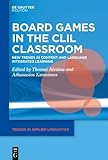Board Games in the CLIL Classroom : New Trends in Content and Language Integrated Learning / ed. by Thomai Alexiou, Athanasios Karasimos.
Material type: TextSeries: Trends in Applied Linguistics [TAL] ; 36Publisher: Berlin ; Boston : De Gruyter Mouton, [2023]Copyright date: ©2024Description: 1 online resource (VI, 269 p.)Content type:
TextSeries: Trends in Applied Linguistics [TAL] ; 36Publisher: Berlin ; Boston : De Gruyter Mouton, [2023]Copyright date: ©2024Description: 1 online resource (VI, 269 p.)Content type: - 9783111000473
- 9783110997255
- 9783110990911
- Board games in education
- Language and languages -- Study and teaching
- Language arts -- Correlation with content subjects
- Brettspiele
- Content and Language Integrated Learning (CLIL)
- Fremdsprachenunterricht
- Spracherwerb
- LANGUAGE ARTS & DISCIPLINES / Linguistics / General
- Board Games
- CLIL
- Language Learning
- Language Teaching
- 418.0078 23/eng/20240208
- P53.298 .B63 2024
- online - DeGruyter
- Issued also in print.
| Item type | Current library | Call number | URL | Status | Notes | Barcode | |
|---|---|---|---|---|---|---|---|
 eBook
eBook
|
Biblioteca "Angelicum" Pont. Univ. S.Tommaso d'Aquino Nuvola online | online - DeGruyter (Browse shelf(Opens below)) | Online access | Not for loan (Accesso limitato) | Accesso per gli utenti autorizzati / Access for authorized users | (dgr)9783110990911 |
Frontmatter -- Contents -- Introduction -- Chapter 1 CLIL-ing through board games: Evidence from class, challenges and perspectives -- Chapter 2 Using board games to practice grammar in adult foreign language classrooms: The case of “Dixit” -- Chapter 3 Once upon a time. . . in Senior High School: Implementing a story-telling board game as a teaching, learning and assessment tool -- Chapter 4 How can board games bridge the gap between content and language learning: The learners’ point of view on the Hunger Grammar Games -- Chapter 5 Using board games for alternative assessment in CLIL -- Chapter 6 The role of games in the CLIL classroom: A case study exploring motivation levels -- Chapter 7 Establishing mutual understanding in CLIL-based L2 game interactions -- Chapter 8 Using games to teach maths in EFL: The case of trainee primary school teachers in France -- Chapter 9 Unlock-ed CLIL: An alternative escape from language classroom -- Chapter 10 Using a word guessing board game to elicit peer-scaffolds in content and language settings in Germany -- Notes on contributors -- Index
restricted access online access with authorization star
http://purl.org/coar/access_right/c_16ec
The present book explores how modern board gaming and language teaching can be beneficially combined to achieve optimal impact. Modern board games have a lot to offer language learners and teachers, and they should play a much more significant role in what has been labelled "Content and Language Integrated Learning" or CLIL. Modern board games require cooperation, problem-solving, active discovery, interpretation and analysis. Most importantly, modern board games allow students to explore a hypothetical environment without the risk of language errors. The key ingredient of the present book is "game-based learning and teaching theory", or GBLTT, a theoretical framework which measures learning outcomes based on gaming and learning procedures. GBLTT is focused on balancing information and gameplay as well as putting a focus on the ability of each learner to retain language competence and to put their subject to realistic situations.
Issued also in print.
Mode of access: Internet via World Wide Web.
In English.
Description based on online resource; title from PDF title page (publisher's Web site, viewed 25. Jun 2024)


